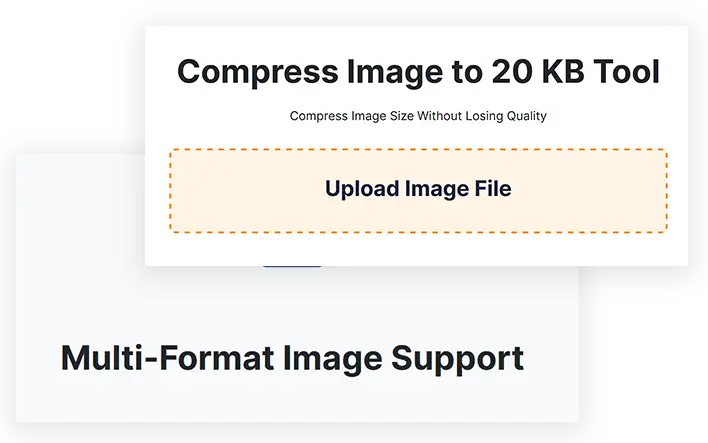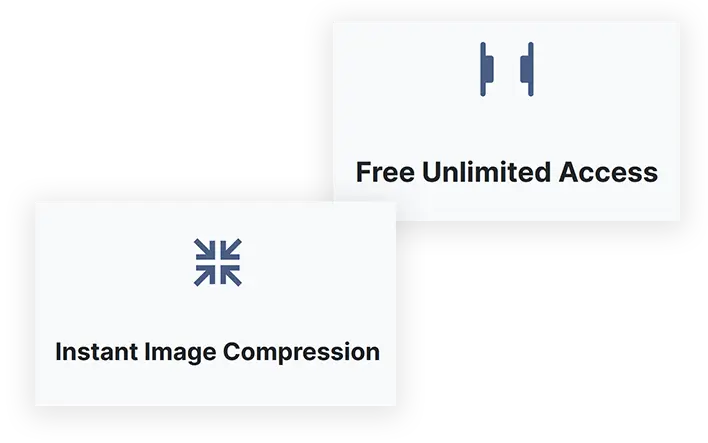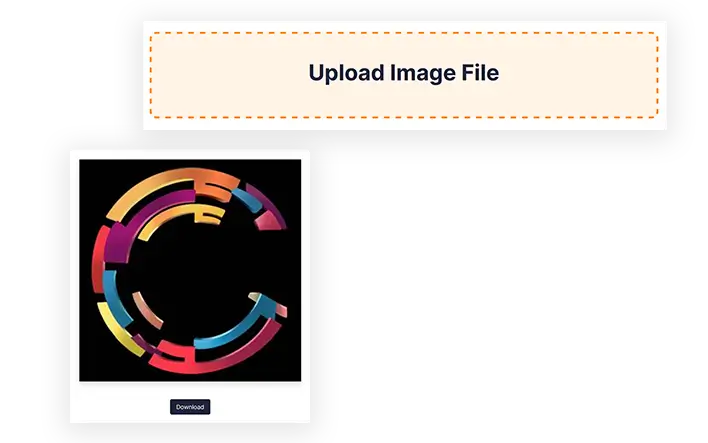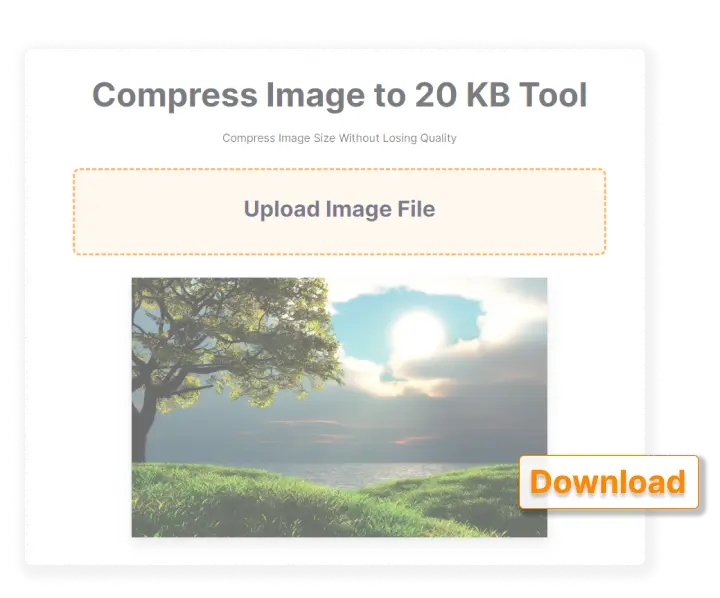The maximum file size that can be compressed using ETTVI's Image Compress to 20kb Tool is 20 kilobytes (KB).
Compress Image to 20 KB Tool
Compress Image Size Without Losing Quality
Drag an Image file to Upload
Press "CTRL + V" to Paste
Features

Multi-Format Image Support

Free Unlimited Access

Instant Image Compression
Related Tools
Compress Image to 20KB
ETTVI has developed a highly intuitive image compress that takes only a second to compress image size to 20kb. Using this tool, you can easily reduce the file size of any type of image. ETTVI’s compress image size to 20kb tool effectively employs the lossy compression algorithms to help you meet the sizing criteria—without compromising quality.
No matter what’s the image file size, ETTVI’s tool will minimize it to 20kb right away. All you need to do is—upload your image and click on “compress image”. ETTVI’s compress image 20kb tool will follow your command and compress the image composition, including color, contrast, and sharpness. The file size will be reduced before you even blink.
ETTVI’s image compress 20kb tool is best to optimize images for platforms and applications where smaller file sizes are desirable. It is accessible for free—no registration is required.
How to Compress Image Size in 20KB?
Here’s the 3-step method that you can follow to compress image size 20kb with ETTVI’s tool:
STEP 1 - Upload
Click on “upload image” to fetch the image file from the connected system. You can upload JPG, JPEG, PNG, or any other commonly used image files.
STEP 2 - Compress
Click on “compress image” to run ETTVI’s 20kb image compressor. It will take only a moment to apply lossy compression method to reduce image size.
STEP 3 - Download
Click on “download image” to save the compressed image on the connected computer system. You can reload to compress as many images as needed.

Why Use ETTVI’s 20KB Image Compress Tool?
ETTVI’s online image compressor offers a variety of features—including an intuitive user interface, lightning-fast results, image quality enhancement, and free unlimited access. Leveraging this tool, anyone can conveniently compress images to reduce their file size.
Here are a few reasons why you should use ETTVI’s 20 kb image compressor tool:
Faster Loading Times: Since large-sized images take longer to load on websites (affecting user experience), ETTVI’s image compress 20kb tool helps to reduce their file size and make the website load faster.
Reduced Storage Space: Since large-sized image files take up more storage space on the computer or server, ETTVI’s 20kb image compress tool online helps to reduce their file size and save storage space.
Quick File Transfers: Since large-sized image files take longer to upload and download (which can be frustrating), ETTVI’s image compressor 20kb helps to reduce their file size and accelerate the file transfers.
Understanding Image Compression and File Formats
Image compression refers to the process of reducing the size of an image file by eliminating redundant information while attempting to maintain the original image quality. There are two primary types of compression algorithms: lossless and lossy.
Lossless Compression: With lossless compression, the file size is reduced without discarding any information. This is done by identifying and removing unnecessary data in the image, which results in a smaller file size without any loss in quality. Lossless compression is typically used for images that must retain their quality, such as scientific or medical images.
Lossy Compression: Conversely, lossy compression involves discarding some of the image data to achieve a smaller file size. This can lead to a reduction in image quality, but the degree of loss can be controlled by adjusting the compression level. This works by identifying parts of the image that can be removed or decreased in quality while attempting to maintain the overall appearance of the image.
This type is commonly used for web-based images, where smaller file sizes are preferred over image quality.
Mastering the art of image compression and file formats can play a pivotal role in choosing the right format and compression level for your specific needs.
With factors like image quality, file size, and compatibility with different platforms and devices in mind, you can select the perfect file format and compression level, optimizing your images for a particular use. Striking a balance between image quality and file size, the right choice can make all the difference in achieving optimal results.

Significance of Low-Sized Images
The compression of images becomes necessary when the images need to be reduced in size. But do you also know why we need a low-sized image? In this section, we will discuss the benefits of low-size images, so the answer to this question can be found here.
There are several benefits of using low-size images on your website or other digital media:
- Faster page load times: Large image files can slow down the loading speed of your web page, which can negatively impact the user experience. By using smaller image files, you can reduce page load times and improve the overall performance of your website.
- Improved mobile user experience: With the increasing use of mobile devices for web browsing, ensuring your website is optimized for mobile devices is essential. Using smaller image files can help reduce the amount of data needed to load your web page, improving the user experience on mobile devices with slower internet connections.
- Reduced bandwidth costs: If you're hosting your images on a web server, using smaller image files can help reduce the bandwidth needed to serve those images to your website visitors. This can help reduce your hosting costs, especially if you have many visitors or a high-traffic website.
- Better search engine optimization: Search engines consider the loading speed of your web page when determining your website's ranking in search results. By using smaller image files, you can improve the loading speed of your web page, which can help improve your search engine rankings.
- Improved accessibility: Using smaller image files can make your website more accessible to users with slower internet connections or limited data plans. This can help ensure all users can access your content, regardless of their internet connection speed.
Choosing The Right File Format For Your Needs
Image file formats have specific characteristics that make them suitable for different types of images. Let's take a closer look at some of the most common file formats.
JPEG: Ideal for Complex Images
JPEG (Joint Photographic Experts Group) is a popular file format for photographs and other complex images. It uses lossy compression, which means it can reduce file sizes while retaining a good level of quality. However, high levels of compression can result in visible artifacts or loss of detail.
PNG: Ideal for Graphics and Logos
PNG (Portable Network Graphics) is a file format that uses lossless compression and is commonly used for graphics, logos, and images with text. PNG files support transparency and can handle large areas of a single color well, making them ideal for logos and other graphical elements.
GIF: Ideal for Simple Animations
GIF (Graphics Interchange Format) is a file format that supports animation and is commonly used for simple animations and low-resolution images. GIF files use lossless compression but are limited to 256 colors, which can result in color banding and loss of detail.
BMP: Ideal for Uncompressed Images
BMP (Bitmap) is a file format that uses no compression and is primarily used for storing images in their original, uncompressed form. BMP files can be very large and are not commonly used on the web, but they are sometimes used for certain applications that require very high-quality images.
TIFF: Ideal for High-Quality Images
TIFF (Tagged Image File Format) is a file format that uses either lossless or lossy compression and is commonly used for high-quality, professional images. TIFF files are capable of storing a lot of image data and are commonly used for printing but can be very large and are not often used on the web.
Understanding the characteristics of different image file formats can help you choose the best format for your particular image and intended use.

Tips For Compressing Images Without Losing Quality
Compressing images without sacrificing quality can be tricky, as reducing file size typically leads to losing detail and clarity. The following tips can help you minimize quality loss while compressing your images:
- Use the suitable file format: Choosing the correct file format can make a big difference in the file size of your image. JPEG is a good option for photographs, while PNG is better for graphics and text.
- Resize your images: Before compressing them, resize them to the appropriate size for their intended use. This will help reduce file size without sacrificing quality.
- Adjust image settings: Most image editing software allows you to adjust the compression settings for your images. Experiment with different compression settings to find the optimal balance between file size and image quality.
- Remove unnecessary data: Remove any unnecessary data from your images, such as metadata, thumbnails, or color profiles. This can help reduce the file size of your images without affecting their quality.
- Prefer to use lossless compression: Lossless compression can be a good option if you need to compress images without losing quality. Formats like GIF and PNG use lossless compression, which means they can compress images without any loss of quality.
By following these tips, you can compress your images without any hassle, making them more suitable for sharing online, emailing, or using on your website.

Frequently Ask Questions
What can file size be compressed using ETTVI's tool?
What image formats are supported by ETTVI's Image Compress to 20kb Tool?
ETTVI's Image Compress to 20kb Tool supports various image formats, including JP, JPEG, and PNG, etc.
Does ETTVI's Image Compressor compromise the quality of the image?
No. ETTVI's Image Compress to 20kb Tool is designed to compress images without compromising quality. However, it is essential to note that reducing the file size of an image may result in a slight loss of quality.
How long does it take to compress an image using ETTVI's Tool?
The time it takes to compress an image using ETTVI's Image Compress to 20kb Tool depends on the image size and the processing power of the device being used. However, in most cases, the tool compresses images quickly.
Is ETTVI's Image Compress to 20kb Tool free to use?
Yes, ETTVI's Image Compress to 20kb Tool is free to leverage for worldwide users. There is no need to sign up or buy any premium subscription to use the tool.

Stay up to date in the email world.
Subscribe for weekly emails with curated articles, guides, and videos to enhance your tactics.




